Dorothea Lange was a natural photographer in the truest sense because she lived, in her words, "a visual life." She could look at something: a line of laundry flapping in the wind, a pair of old, wrinkled, work-worn hands, a bread-line, a crowd of people in a bus station, and find it beautiful. Her eye was a camera lens and her camera--as she put it--an "appendage of the body." During her last illness, as a friend sat near her bed, she suddenly said to him "I've just photographed you." Lange had engaged in this camera-less sort of photography for decades, from the time she was a young girl, and it served as both the foundation of her art education and her first apprenticeship.
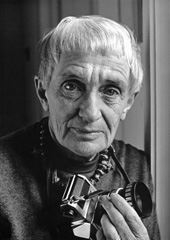 Dorothea LangeRondal Partridge. Courtesy of Elizabeth and Rondal Patridge. Used with permission.
Dorothea LangeRondal Partridge. Courtesy of Elizabeth and Rondal Patridge. Used with permission.
Bored and disillusioned with school, she would often cut class and go walking through her neighborhood, the lower-east side of New York. She would make herself as unobtrusive as possible, and look at things and people. Down-and-outs of the Bowery, bustling marketplaces, the Jewish ladies in their schechtels, or black wigs.
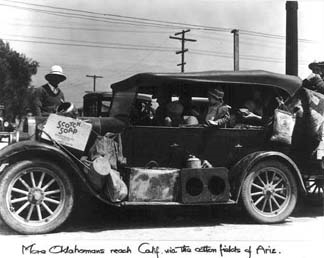 |
|
Migrant workers, 1935. Annotation reads: "More Oklahomans reach California via the cotton fields of Arizona." Paul Taylor and Dorothea Lange, Migration of Draught Refugees to California, California State Emergency Relief Administration, April 1935, p. 12. Prints and Photographs Division, Library of Congress (89) LOT 897. Source: http://www.loc.gov/exhibits/wcf/images/wcf089.jpg |
Although she was never able to get rid of the vestiges of polio, Dorothea dropped the memory of her father almost completely. She took her mother's maiden name, Lange, as her own last name, and refused to speak of her father, even to her own children.
| "You force yourself onto strange streets, among strangers. It may be very hot. It may be painfully cold. It may be sandy and windy and you say, 'What am I doing here? What drives me to do this hard thing?' " |
The pain of her childhood, however, gave her a fuller sense of what suffering meant, and later on, when the government hired her to document the effects of the depression, it deepened her compassion for the destitution and despair that she saw all around her.
She would walk into camps, where homeless pea-pickers and refugees of the Oklahoma dust bowl were scraping by, sometimes starving to death, and talk to them until they felt comfortable enough to have their pictures taken. Her limp, she thought, created an instant rapport between herself and her subjects. She said that people trusted her more because she didn't appear "whole and secure" in the face of their poverty and insecurity.
Lange was born May 26, 1895, in Hoboken, New Jersey, where two painful events left indelible marks on her life.
| "One should really use the camera as though tomorrow you'd be stricken blind. To live a visual life is an enormous undertaking, practically unattainable. I've only touched it, just touched it." |
When she was seven years old, she contracted polio, which left her with an obvious limp. The neighborhood children made fun of her and even her mother, Joan, acted ashamed of her crippled daughter.
Then in 1907, when she was twelve, her father walked out on the family. They neither saw or heard from him again. They moved into the home of Sophie Lange, the children’s maternal grandmother, and great-aunt Caroline. Joan took a job as a librarian in Manhattan. It was during long walks through downtown Manhattan to meet her mother after school that Dorothea discovered a wealth of visual imagery and decided that she wanted to take photographs.
| "Artists are controlled by the life that beats in them, like the ocean beats on the shore." |
Dorothea was fiercely independent. Instead of becoming a teacher as her mother wanted, she went uptown to the studio of a famous portrait photographer, Arnold Genthe, and asked him for a job. She was hired, and her life's work began. She learned how to set up a camera and studio lights, met many rich and famous people, and studied the artistry with which Genthe portrayed people: he didn't just snap their picture; he seemed to make the camera understand the people. This sense that an understanding of a subject was essential in making a portrait was truly the artistic part of photography, and something that Dorothea would take with her for the rest of her career.
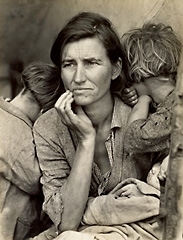 |
|
Migrant Mother, 1936 Photo by Dorothea Lange [Public Domain] via Library of Congress (Source: https://www.loc.gov/item/2017762891/) |
Although she got her start and made most of her money taking portraits of wealthy people, Lange preferred the deeper challenge of photographing the real human condition. Wherever there was social upheaval, or quiet suffering, Lange was there with a compassionate eye to record and report.
| "I had to get my camera to register things that were more important than how poor they were--their pride, their strength, their spirit." |
During the depression, the government created work for writers, scholars and artists through various documentary assignments, and Lange was fortunate to get such a position. She took pictures of the labor strikes in San Francisco. She travelled to the deep South with her partner and husband, Paul Taylor, photographing out-of-work sharecroppers and their families. She went to Oklahoma to take pictures of dust-bowl emigrants, and went up and down California, meeting and photographing the homeless families who had come in search of work. During this time she took "Migrant Mother" which was to become her most famous picture.
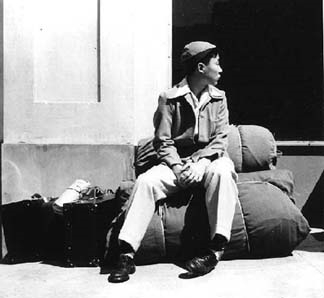 |
|
Japanese boy awaiting evacuation, June 1942 Photo by Dorothea Lange [Public Domain] via Library of Congress Source: https://www.loc.gov/item/00651207/ |
Following the attack on Pearl Harbor, she took heart-rending pictures of the Japanese families as they were evacuated from their homes and sent to prison camps.
| "The pageant is vast and I clutch at tiny details, inadequate." |
She was disgusted that the government would lock people up not because of anything they had done, but solely because of their Japanese blood. She recorded the San Francisco shipyard workers, taking advantage of the war and the need for ship-builders to make their first real wages since the depression began.
By the 1960s, Lange was a nationally-known photographer who was surrounded by an extensive network of family and friends. She was also famous (on a smaller scale) for her
| "A photographer's files are, in a sense, his autobiography. More resides there than he is aware of. ...As fragmentary and incomplete as the archaeologist's pot sherds, it can be no less telling." |
Thanksgiving dinners, which she spent weeks planning for and preparing, and which culminated in huge gatherings where the ritual would begin with a reading of the proclamation of Thanksgiving. In 1965, the last year of her life, Dorothea Lange was honored by a retrospective of her work at the Museum of Modern Art in New York City. Elizabeth Partridge, daughter of photographer Rondal Partridge who worked as Lange's assistant for many years and whose family Lange took into her own, has written about this remarkable artist in the biography Restless Spirit: the Life and Work of Dorothea Lange. Dorothea Lange died October 11, 1965.
Page created on 9/2/2009 3:33:30 PM
Last edited 9/28/2021 10:25:09 PM
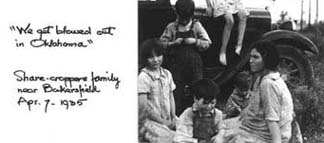 |
| Migrant workers, 1935. Annotation reads: " 'We got blowed out in Oklahoma' / Sharecroppers family near Bakersfield" |
